Abstract
Insertion of introns into cloned cDNA of two isolates of the plant potyvirus pea seedborne mosaic virus facilitated plasmid amplification in Escherichia coli. Multiple stop codons in the inserted introns interrupted the open reading frame of the virus cDNA, thereby terminating undesired translation of virus proteins in E. coli. Plasmids containing the full-length virus sequences, placed under control of the cauliflower mosaic virus 35S promoter and the nopaline synthase termination signal, were stable and easy to amplify in E. coli if one or more introns were inserted into the virus sequence. These plasmids were infectious when inoculated mechanically onto Pisum sativum leaves. Examination of the cDNA-derived viruses confirmed that intron splicing of in vivo transcribed pre-mRNA had occurred as predicted, reestablishing the virus genome sequences. Symptom development and virus accumulation of the cDNA derived viruses and parental viruses were identical. It is proposed that intron insertion can be used to facilitate manipulation and amplification of cloned DNA fragments that are unstable in, or toxic to, E. coli. When transcribed in vivo in eukaryotic cells, the introns will be eliminated from the sequence and will not interfere with further analysis of protein expression or virus infection.
Full text
PDF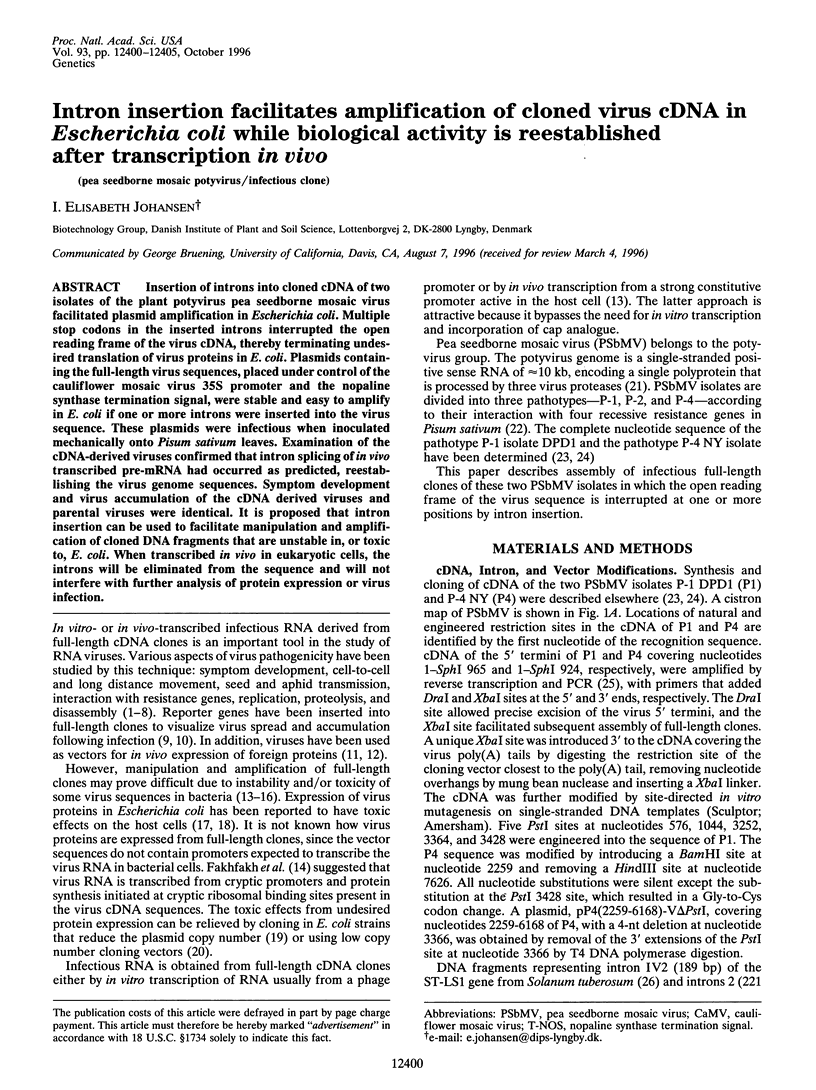
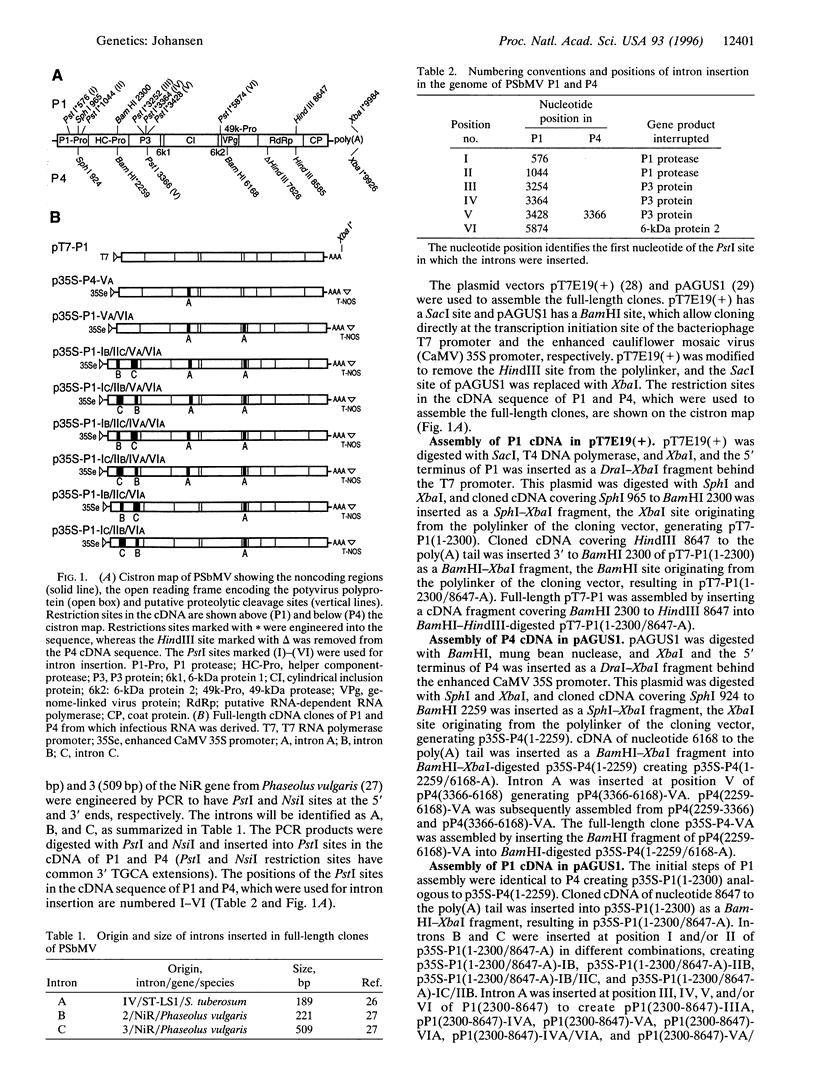
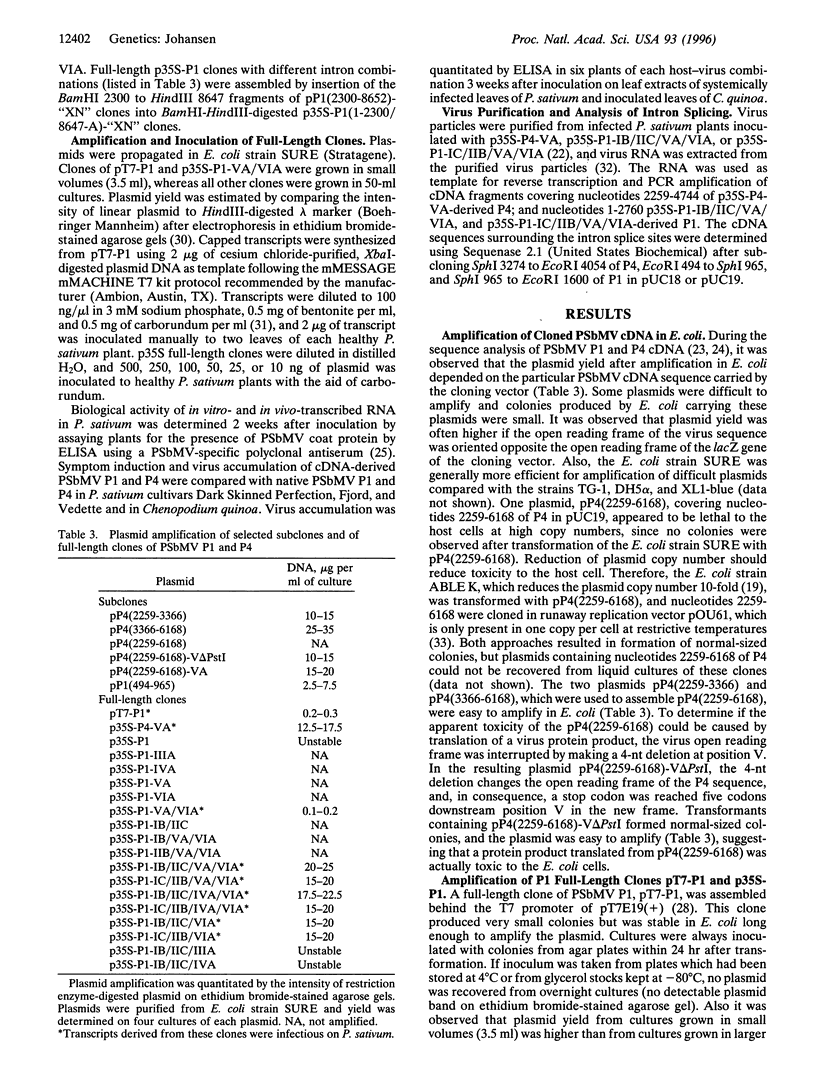
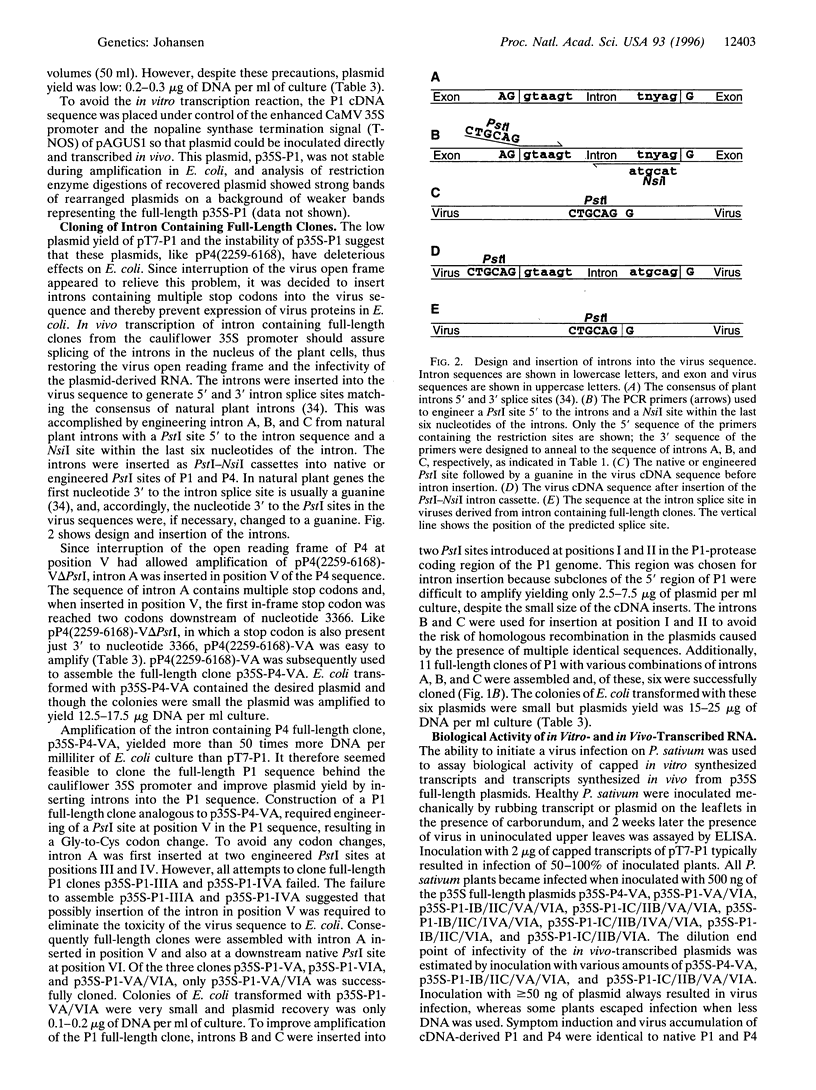
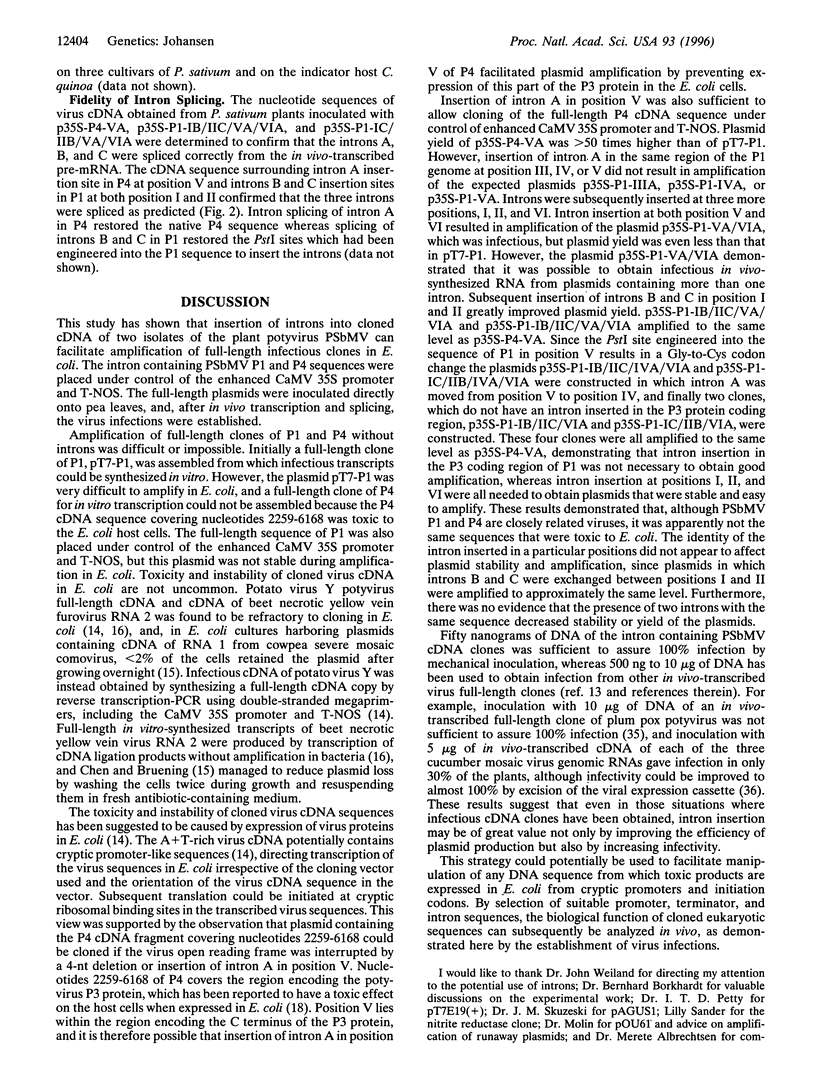
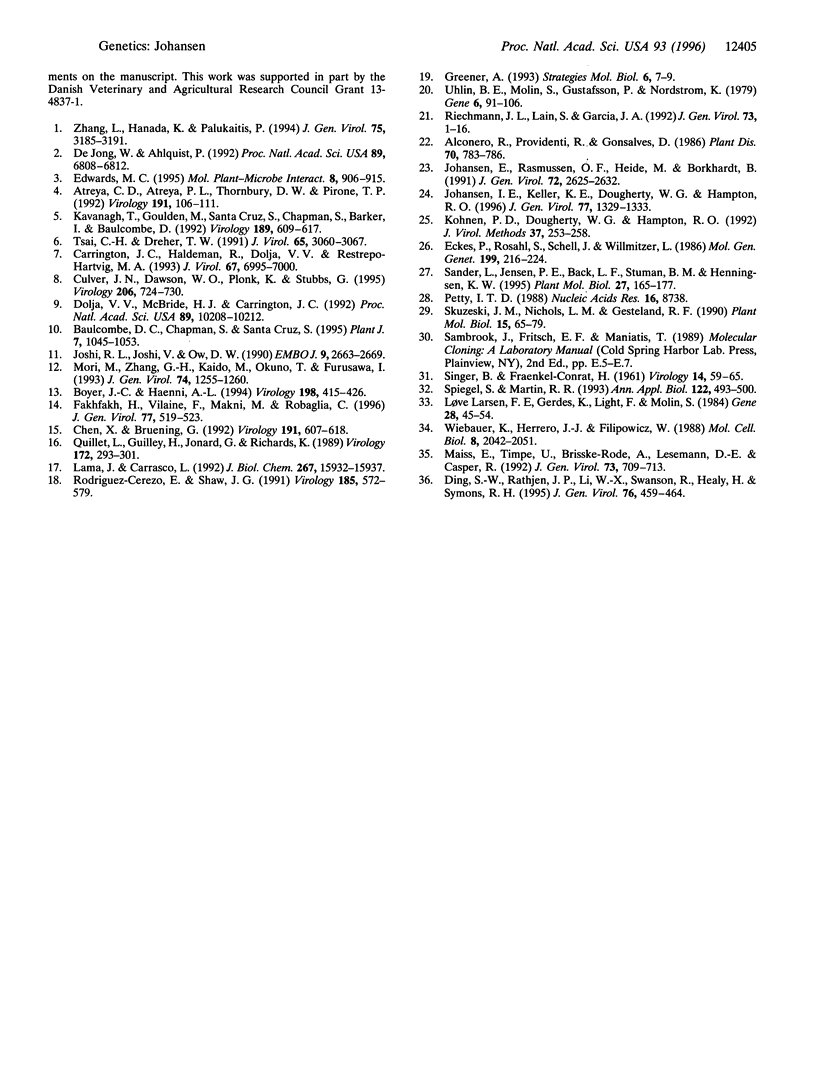
Selected References
These references are in PubMed. This may not be the complete list of references from this article.
- Atreya C. D., Atreya P. L., Thornbury D. W., Pirone T. P. Site-directed mutations in the potyvirus HC-Pro gene affect helper component activity, virus accumulation, and symptom expression in infected tobacco plants. Virology. 1992 Nov;191(1):106–111. doi: 10.1016/0042-6822(92)90171-k. [DOI] [PubMed] [Google Scholar]
- Baulcombe D. C., Chapman S., Santa Cruz S. Jellyfish green fluorescent protein as a reporter for virus infections. Plant J. 1995 Jun;7(6):1045–1053. doi: 10.1046/j.1365-313x.1995.07061045.x. [DOI] [PubMed] [Google Scholar]
- Boyer J. C., Haenni A. L. Infectious transcripts and cDNA clones of RNA viruses. Virology. 1994 Feb;198(2):415–426. doi: 10.1006/viro.1994.1053. [DOI] [PubMed] [Google Scholar]
- Carrington J. C., Haldeman R., Dolja V. V., Restrepo-Hartwig M. A. Internal cleavage and trans-proteolytic activities of the VPg-proteinase (NIa) of tobacco etch potyvirus in vivo. J Virol. 1993 Dec;67(12):6995–7000. doi: 10.1128/jvi.67.12.6995-7000.1993. [DOI] [PMC free article] [PubMed] [Google Scholar]
- Chen X., Bruening G. Cloned DNA copies of cowpea severe mosaic virus genomic RNAs: infectious transcripts and complete nucleotide sequence of RNA 1. Virology. 1992 Dec;191(2):607–618. doi: 10.1016/0042-6822(92)90236-i. [DOI] [PubMed] [Google Scholar]
- Culver J. N., Dawson W. O., Plonk K., Stubbs G. Site-directed mutagenesis confirms the involvement of carboxylate groups in the disassembly of tobacco mosaic virus. Virology. 1995 Jan 10;206(1):724–730. doi: 10.1016/s0042-6822(95)80096-4. [DOI] [PubMed] [Google Scholar]
- De Jong W., Ahlquist P. A hybrid plant RNA virus made by transferring the noncapsid movement protein from a rod-shaped to an icosahedral virus is competent for systemic infection. Proc Natl Acad Sci U S A. 1992 Aug 1;89(15):6808–6812. doi: 10.1073/pnas.89.15.6808. [DOI] [PMC free article] [PubMed] [Google Scholar]
- Ding S. W., Rathjen J. P., Li W. X., Swanson R., Healy H., Symons R. H. Efficient infection from cDNA clones of cucumber mosaic cucumovirus RNAs in a new plasmid vector. J Gen Virol. 1995 Feb;76(Pt 2):459–464. doi: 10.1099/0022-1317-76-2-459. [DOI] [PubMed] [Google Scholar]
- Dolja V. V., McBride H. J., Carrington J. C. Tagging of plant potyvirus replication and movement by insertion of beta-glucuronidase into the viral polyprotein. Proc Natl Acad Sci U S A. 1992 Nov 1;89(21):10208–10212. doi: 10.1073/pnas.89.21.10208. [DOI] [PMC free article] [PubMed] [Google Scholar]
- Edwards M. C. Mapping of the seed transmission determinants of barley stripe mosaic virus. Mol Plant Microbe Interact. 1995 Nov-Dec;8(6):906–915. doi: 10.1094/mpmi-8-0906. [DOI] [PubMed] [Google Scholar]
- Fakhfakh H., Vilaine F., Makni M., Robaglia C. Cell-free cloning and biolistic inoculation of an infectious cDNA of potato virus Y. J Gen Virol. 1996 Mar;77(Pt 3):519–523. doi: 10.1099/0022-1317-77-3-519. [DOI] [PubMed] [Google Scholar]
- Johansen E., Rasmussen O. F., Heide M., Borkhardt B. The complete nucleotide sequence of pea seed-borne mosaic virus RNA. J Gen Virol. 1991 Nov;72(Pt 11):2625–2632. doi: 10.1099/0022-1317-72-11-2625. [DOI] [PubMed] [Google Scholar]
- Johansen I. E., Keller K. E., Dougherty W. G., Hampton R. O. Biological and molecular properties of a pathotype P-1 and a pathotype P-4 isolate of pea seed-borne mosaic virus. J Gen Virol. 1996 Jun;77(Pt 6):1329–1333. doi: 10.1099/0022-1317-77-6-1329. [DOI] [PubMed] [Google Scholar]
- Joshi R. L., Joshi V., Ow D. W. BSMV genome mediated expression of a foreign gene in dicot and monocot plant cells. EMBO J. 1990 Sep;9(9):2663–2669. doi: 10.1002/j.1460-2075.1990.tb07451.x. [DOI] [PMC free article] [PubMed] [Google Scholar]
- Kavanagh T., Goulden M., Santa Cruz S., Chapman S., Barker I., Baulcombe D. Molecular analysis of a resistance-breaking strain of potato virus X. Virology. 1992 Aug;189(2):609–617. doi: 10.1016/0042-6822(92)90584-c. [DOI] [PubMed] [Google Scholar]
- Kohnen P. D., Dougherty W. G., Hampton R. O. Detection of pea seedborne mosaic potyvirus by sequence specific enzymatic amplification. J Virol Methods. 1992 Jun;37(3):253–258. doi: 10.1016/0166-0934(92)90027-b. [DOI] [PubMed] [Google Scholar]
- Lama J., Carrasco L. Expression of poliovirus nonstructural proteins in Escherichia coli cells. Modification of membrane permeability induced by 2B and 3A. J Biol Chem. 1992 Aug 5;267(22):15932–15937. [PubMed] [Google Scholar]
- Larsen J. E., Gerdes K., Light J., Molin S. Low-copy-number plasmid-cloning vectors amplifiable by derepression of an inserted foreign promoter. Gene. 1984 Apr;28(1):45–54. doi: 10.1016/0378-1119(84)90086-6. [DOI] [PubMed] [Google Scholar]
- Maiss E., Timpe U., Brisske-Rode A., Lesemann D. E., Casper R. Infectious in vivo transcripts of a plum pox potyvirus full-length cDNA clone containing the cauliflower mosaic virus 35S RNA promoter. J Gen Virol. 1992 Mar;73(Pt 3):709–713. doi: 10.1099/0022-1317-73-3-709. [DOI] [PubMed] [Google Scholar]
- Mori M., Zhang G. H., Kaido M., Okuno T., Furusawa I. Efficient production of human gamma interferon in tobacco protoplasts by genetically engineered brome mosaic virus RNAs. J Gen Virol. 1993 Jul;74(Pt 7):1255–1260. doi: 10.1099/0022-1317-74-7-1255. [DOI] [PubMed] [Google Scholar]
- Petty I. T. A plasmid vector for cloning directly at the transcription initiation site of a bacteriophage T7 promoter. Nucleic Acids Res. 1988 Sep 12;16(17):8738–8738. doi: 10.1093/nar/16.17.8738. [DOI] [PMC free article] [PubMed] [Google Scholar]
- Quillet L., Guilley H., Jonard G., Richards K. In vitro synthesis of biologically active beet necrotic yellow vein virus RNA. Virology. 1989 Sep;172(1):293–301. doi: 10.1016/0042-6822(89)90131-1. [DOI] [PubMed] [Google Scholar]
- Riechmann J. L., Laín S., García J. A. Highlights and prospects of potyvirus molecular biology. J Gen Virol. 1992 Jan;73(Pt 1):1–16. doi: 10.1099/0022-1317-73-1-1. [DOI] [PubMed] [Google Scholar]
- Rodríguez-Cerezo E., Shaw J. G. Two newly detected nonstructural viral proteins in potyvirus-infected cells. Virology. 1991 Dec;185(2):572–579. doi: 10.1016/0042-6822(91)90527-i. [DOI] [PubMed] [Google Scholar]
- Sander L., Jensen P. E., Back L. F., Stummann B. M., Henningsen K. W. Structure and expression of a nitrite reductase gene from bean (Phaseolus vulgaris) and promoter analysis in transgenic tobacco. Plant Mol Biol. 1995 Jan;27(1):165–177. doi: 10.1007/BF00019188. [DOI] [PubMed] [Google Scholar]
- Skuzeski J. M., Nichols L. M., Gesteland R. F. Analysis of leaky viral translation termination codons in vivo by transient expression of improved beta-glucuronidase vectors. Plant Mol Biol. 1990 Jul;15(1):65–79. doi: 10.1007/BF00017725. [DOI] [PubMed] [Google Scholar]
- Tsai C. H., Dreher T. W. Turnip yellow mosaic virus RNAs with anticodon loop substitutions that result in decreased valylation fail to replicate efficiently. J Virol. 1991 Jun;65(6):3060–3067. doi: 10.1128/jvi.65.6.3060-3067.1991. [DOI] [PMC free article] [PubMed] [Google Scholar]
- Uhlin B. E., Molin S., Gustafsson P., Nordström K. Plasmids with temperature-dependent copy number for amplification of cloned genes and their products. Gene. 1979 Jun;6(2):91–106. doi: 10.1016/0378-1119(79)90065-9. [DOI] [PubMed] [Google Scholar]
- Wiebauer K., Herrero J. J., Filipowicz W. Nuclear pre-mRNA processing in plants: distinct modes of 3'-splice-site selection in plants and animals. Mol Cell Biol. 1988 May;8(5):2042–2051. doi: 10.1128/mcb.8.5.2042. [DOI] [PMC free article] [PubMed] [Google Scholar]
- Zhang L., Handa K., Palukaitis P. Mapping local and systemic symptom determinants of cucumber mosaic cucumovirus in tobacco. J Gen Virol. 1994 Nov;75(Pt 11):3185–3191. doi: 10.1099/0022-1317-75-11-3185. [DOI] [PubMed] [Google Scholar]


